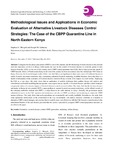| dc.contributor.author | Mbogoh, S G | |
| dc.contributor.author | Gathuma, JM | |
| dc.date.accessioned | 2013-07-26T12:13:51Z | |
| dc.date.available | 2013-07-26T12:13:51Z | |
| dc.date.issued | 2012 | |
| dc.identifier.citation | Mbogoh, S.G. and Gathuma, J.M. (2012). Methodological issues and applications in economic evaluation of alternative livestock diseases control 11 strategies: The case of the CBPP quarantine line in North-Eastern Kenya. Journal of Agricultural Science and Technology A 2 (5), 640-659. | en |
| dc.identifier.uri | http://erepository.uonbi.ac.ke:8080/xmlui/handle/123456789/51647 | |
| dc.description.abstract | Contagious bovine pleuro-pneumonia (CBPP) is one of the endemic and life-threatening livestock diseases in the arid and
semi-arid land areas (ASALs) of Kenya, which justify the case for the control of livestock diseases to avoid the spread of such
diseases from the ASALs to the rest of the country, and a CBPP control quarantine line (CQL) that to help prevent the spread of
CBPP from the ASALs of North-eastern Kenya to the rest of the country has been in existence since the colonial (pre-1963) times in
Kenya. However, the livestock keepers in the ASALs view the CQL as an impediment to their main source of livelihoods because it
entails livestock movement restrictions, thus constraining unfettered livestock marketing. Available literature shows that there is a
dearth of information on the economics of livestock diseases control in Kenya in terms of its impacts on social welfare. Employing
the CQL as a case study, this study shows that an application of analytic techniques that combine disease risk analysis and
conventional cost-benefit modelling that incorporates some aspects that are specific to livestock diseases and their control strategies
can generate indices of economic impacts of livestock diseases control on social welfare. The study finds that the livestock keepers
and traders in Kenya do not consider CBPP a major problem to warrant livestock movement restrictions, yet the official records of
the veterinary authorities indicate that CBPP is a major threat to the cattle industry in Kenya. Annually, the government spends
substantial resources on the CQL operation and maintenance and also on CBPP surveillance and monitoring to contain the CBPP
menace in Kenya. This study shows that such expenditures are economically and socially justifiable. Nevertheless, the study finds
some operational inefficiencies in the enforcement of the CQL requirements. The authors, therefore, undertake an evaluation of
alternative CBPP control strategies and conclude that it would be more cost effective to shift the CQL from its current location to the
international borders of the arid districts, provided that this action is preceded by adequate CBPP control preparatory measures, as
described in the paper. | en |
| dc.language.iso | en | en |
| dc.publisher | University of Nairobi | en |
| dc.subject | Evaluation, livestock diseases control, CBPP, pastoralists, marketing, welfare, Kenya | en |
| dc.title | Methodological Issues and Applications in Economic Evaluation of Alternative Livestock Diseases Control Strategies: The Case of the CBPP Quarantine Line in North-Eastern Kenya | en |
| dc.type | Article | en |
| local.publisher | Department of Veterinary Public Health, Pharmacology and Toxicology, Faculty of Veterinary Medicine, University of Nairobi. | en |

